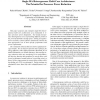1481 search results - page 21 / 297 » Optimal Reductions in Interaction Systems |
105
Voted
MICRO
2003
IEEE
15 years 5 months ago
2003
IEEE
This paper proposes and evaluates single-ISA heterogeneous multi-core architectures as a mechanism to reduce processor power dissipation. Our design incorporates heterogeneous cor...
123
click to vote
EUSFLAT
2009
14 years 10 months ago
2009
One of the new trends in genetic fuzzy systems (GFS) is the use of evolutionary multiobjective optimization (EMO) algorithms. This is because EMO algorithms can easily handle two c...
123
Voted
ISCAS
1999
IEEE
15 years 4 months ago
1999
IEEE
The energy usage of computer systems is becoming important, especially for portablebattery-operated applications and embedded systems. A significant reduction in the energy consum...
79
Voted
DAC
2005
ACM
16 years 1 months ago
2005
ACM
Existing Full-wave Model Order Reduction (FMOR) approaches are based on Expanded Taylor Series Approximations (ETAS) of the oscillatory full-wave system matrix. The accuracy of su...
128
click to vote
LION
2010
Springer
15 years 5 months ago
2010
Springer
Abstract This paper proposes a flexible software architecture for interactive multiobjective optimization, with a user interface for visualizing the results and facilitating the s...

